Gulf & Caribbean
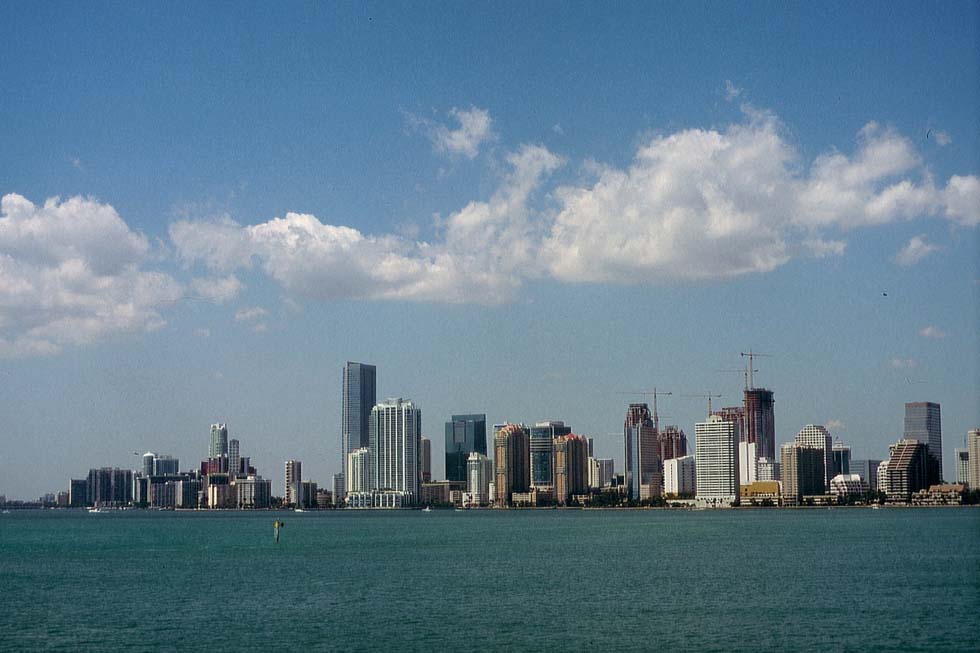
Miami (WS)
Surely the oddest ride we ever had, was aboard the ferry-like "Horizon's Edge" departing from Miami. A four hours round trip at 20 dollar, that's a steal. Entering the nice ship, it becomes clear why the fare is so cheap. The decks one and two are almost completely packed with slot machines, only deck three is a viewing point - and nobody takes place there. The view is breathtaking after departure, first the skyscrapers of Miami Downtown and of the South Point, then the panorama is opening up from the North Beach to Key Biscayne in the south. Beyond miles across the blue sea, under the dazzling sun, there must be the Florida Keys, the chain of islands connected by bridges and a dam, ending at Key West, where once the steamers for Cuba had their departure. The "Horizon's Edge" is rolling softly in the sea, on the almost empty viewing deck a duo is playing a wonderful Cuban music and the few elderly people sitting there speak Spanish. Surely they dream now of a voyage to Cuba, to their native country, barricaded...
 "Horizon's Edge", 2007 (WS)
"Horizon's Edge", 2007 (WS)
The Gulf
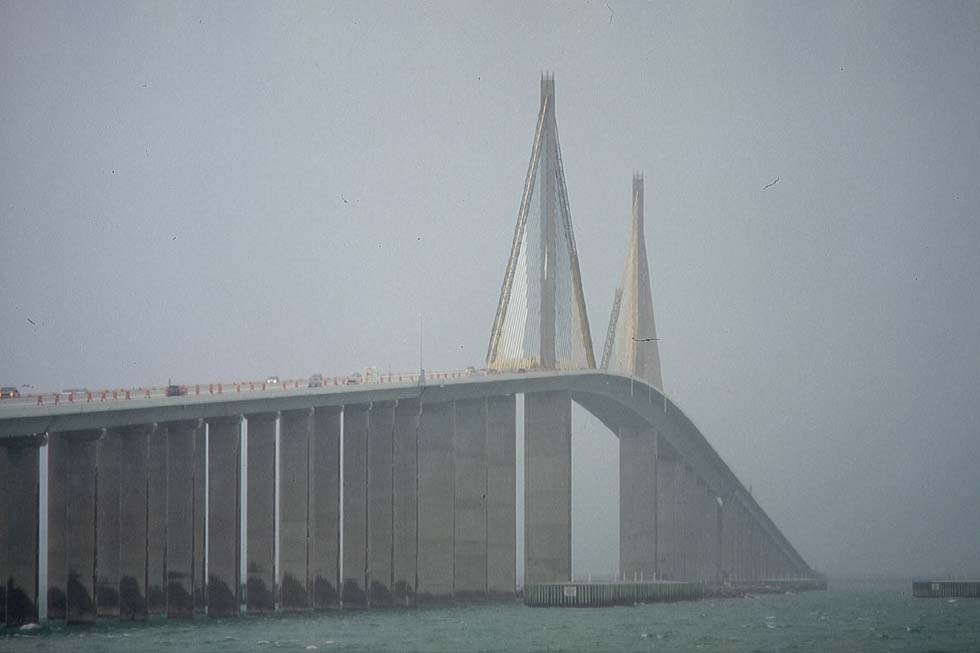
Sunshine Skyway Bridge, Tampa Bay, Florida (WS)
Liberation of the states situated between North and South America had started in the early 19th century. Steam shipping in the Gulf of Mexico and the Caribbean was pioneered with foundation of the famous Pacific Mail Steamship Co. or PMSSCo in 1848 after the end of the Mexican War. Then the Gold Rush boosted traffic and the steamers of more than half a dozen companies crossed the sea, providing a connection with California via Panama - see main chapter South Atlantic/ Caribbean. Passengers for departure at New Orleans could use from 1856 the Illinois Central railroad, which connected at Cairo, the confluence of the Ohio and Mississippi Rivers, with the Blue Line packet steamers to New Orleans, until in 1889 through trains from Chicago to New Orleans could start. When the Panama Canal was under construction, that name symbolized the maturity of the United States and consequently the name of the premier train Chicago - New Orleans changed in 1911 to 'Panama Limited'. In 1906 the Illinois Central has come under control of Edward H. Harriman, owner of the Southern Pacific Lines railroad system and of the Southern Pacific Steamship Line. An advertisement e.g. of 1916 proclaimed shipping services under the designation 'Southern Pacific S.S. Line (Morgan Line)' from New Orleans to New York and to Havana. The official Guide of that year showed also the Morgan Line New York - New Orleans - Galveston as well as passenger-cargo services of the United Fruit Co. from New Orleans (Julia Wharf) to Jamaica, Puerto Barrios in Guatemala, Tela in Honduras and Bocas del Toro in Panama. Galveston was served also by the Mallory Line, Port Arthur in Texas by the Seaboard & Gulf S.S. Co. and Tampa in Florida by the Peninsular & Occidental, the Tampa & Gulf S.S. Co. and coastal steamers of the Favorite Line. Between the wars, the Gulf Mail S.S. Co. was listed with a route New Orleans - Mexico.
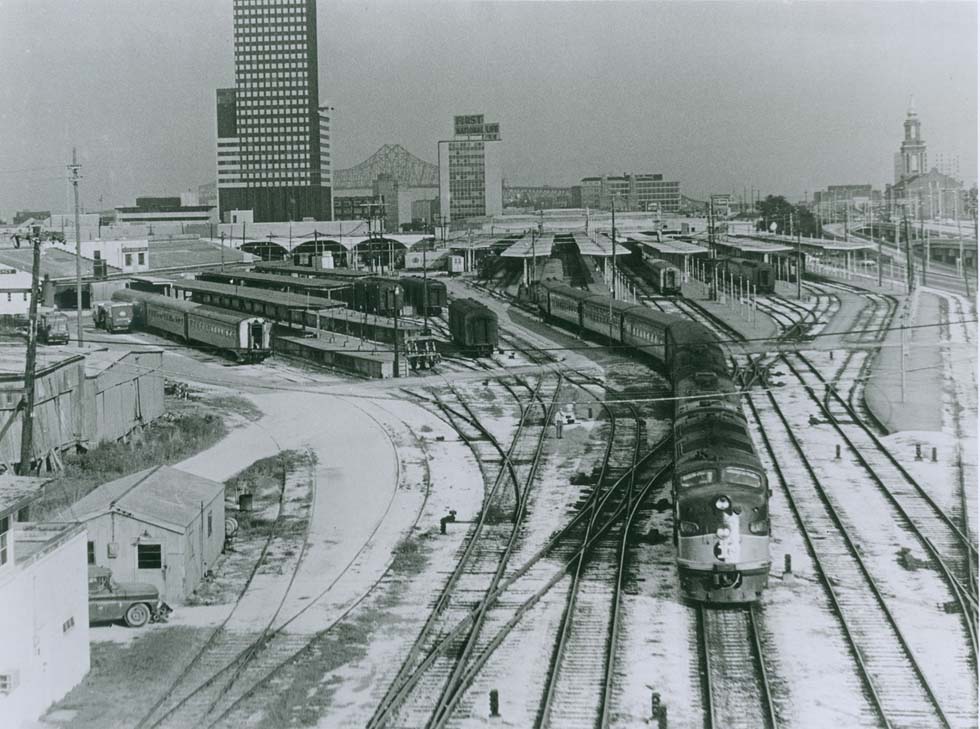
'Panama Limited' leaving New Orleans, 1970 (Illinois Central Railroad)
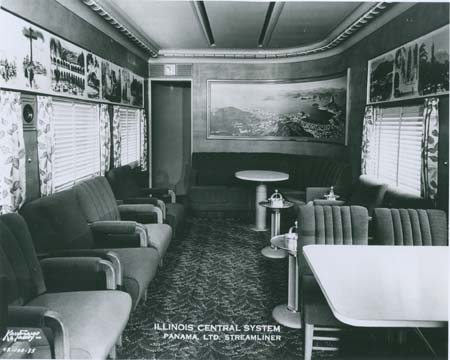
'Panama Limited' (Illinois Central Railroad)
|
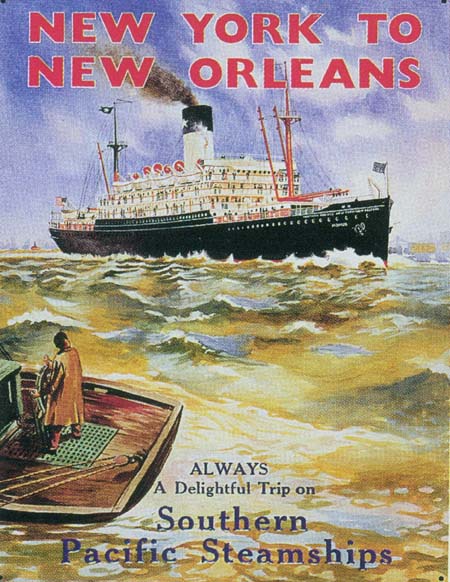
Southern Pacific Steamship Line (old ad)
|
Another matter was the amelioration of traffic between Canada and British colonies in the south, concluded in 1925. Canadian National Steamships introduced in 1928/29 five passenger-cargo ships, the 8,194-ton "Lady Rodney" and "Lady Somers" for the Jamaica route and the "Lady Drake", "Lady Hawkins" and "Lady Nelson" for the British Guyana route (as described by Laurence Dunn). The "Lady Rodney" and "Lady Nelson" found their end in Egypt (see chapter Arabia).
Cuba, Puerto Rico, Bahamas
Cuba and Puerto Rico had been annexed by the USA in 1898. Ward Line steamers connected Havana with New York, the Munson Line with Mobile and the Peninsular & Occidental with Tampa. The shortest way to Cuba was established in 1912 when Henry M. Flagler extended his Florida East Coast Railway to Key West, the outermost of the Florida Key Islands, only 90 miles from Havana. The 'Special' from New York discharged passengers onto the 1,200-feet Key West pier for transfer to the Peninsular & Occidental steamer, e.g. the "Governor Cobb", and after a 6-hour sail the vacationers would be setting foot at Havana, as Arthur D. Dubin described it. In 1935 a hurricane destroyed the railway to Key West. Passengers could use the black/white steamers of the Peninsular & Occidental or a steamer of the Havana-American S.S. Co. departing from Miami to Cuba. And they could travel from New York to Florida by steamers of the Miami S.S. Co., the Mallory Line or straight to the Caribbean islands by Incres Nassau Line and the various ocean liners. The Porto Rico Line connected New York with Puerto Rico, their largest steamer before WWI being the two-funnel "Brazos".
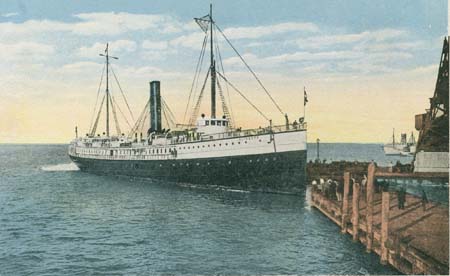
"Olivette" of P.& O., Port Tampa - Cuba service (old card, coll. WS)
|
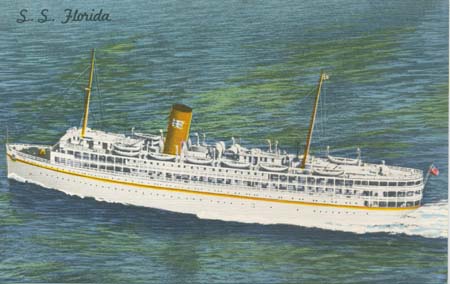
"Florida" of P.& O., Miami - Nassau cruises (old card, coll. WS)
|
For the rising tourism to Cuba, the Bahamas and the Bermudas see the main chapter South Atlantic/ Caribbean. Also on Bahamas services the Peninsular & Occidental Steamship Co. was engaged in the tourist business. The Bahamas and the Caribbean became more and more popular as destinations and in some cases it was difficult to distinguish between seasonal regular services and cruises. An Israeli company of Miami started a sort of ferry cruises to Nassau in 1964. Then joined by Ted Arison, the Arison Shipping Company was founded in 1966 for marketing two ferries as 'floating motels', but soon the ship-owners went bankrupt and in December 1966 Arison started together with Knut Kloster and his car-ferry "Sunward" modern cruising - see chapter Cruises.
After the jet airliners' victory over the classic ocean liners, ABC Shipping Guide listed at the end of the 70s the Bahamas Hydrofoil Cruises between Miami and Nassau, where once the Peninsular & Occidental steamers had operated regularly. Home Lines offered a New York - Bermudas - Bahamas service with the "Doric" (1964/ 17,884 gt, ex "Shalom", "Hanseatic") and the "Oceanic" (1965/ 27,645 gt). The Commodore Cruise Line chartered for quasi-regular services Miami - St. Thomas - San Juan the "Boheme" (1968/ 9,866 gt) and the "Caribe" (1968/ 10,488 gt, ex "Freeport", "Svea Star"). She became in 1994 the "Discovery Sun" of Discovery Cruise Line. In 1982 Scandinavian World Cruises introduced the 26,747-ton car ferry "Scandinavia" on the New York - Bahamas route. More and more however those services changed to pure cruises and the surviving regular services are the Bahamas Ferries inter-island links of the Bahamas Port Authority. In 1991 Sea Containers bought the car ferry "Fedra" of Minoan, the former "Peter Pan" of TT-Line, for a service Florida - Mexico, but it was not possible to find any confirmation by Cook's timetables. More modest, but nice for tourists, are the services between Miami, Key West and Fort Myers by Key West Express.
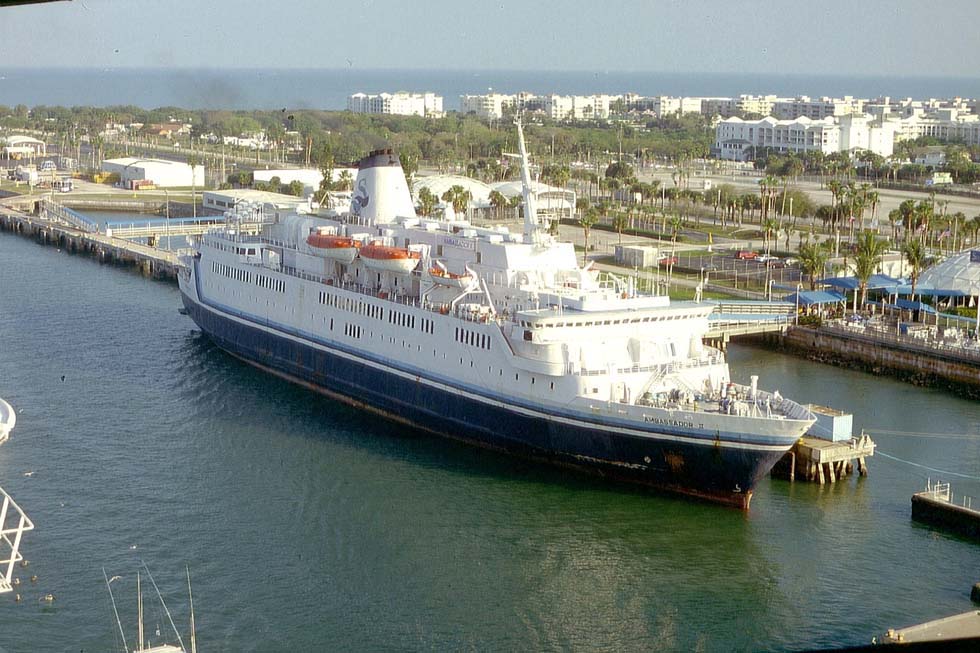
"Ambassador II", Port Canaveral 2008 (WS)
A species of its own is represented by the casino ships. An astonishing career had the "Ambassador II" of Sterling Casino Cruises. Completed in 1970 as the 8,093-ton car-ferry "Prins Oberon", she provided services Bremerhaven - Harwich for Prinzenlinien. After a dozen changes in ownership, she started in 1999 regular tours from Port Canaveral, announced as "World's Largest Casino Ship".
Caribbean Ferries
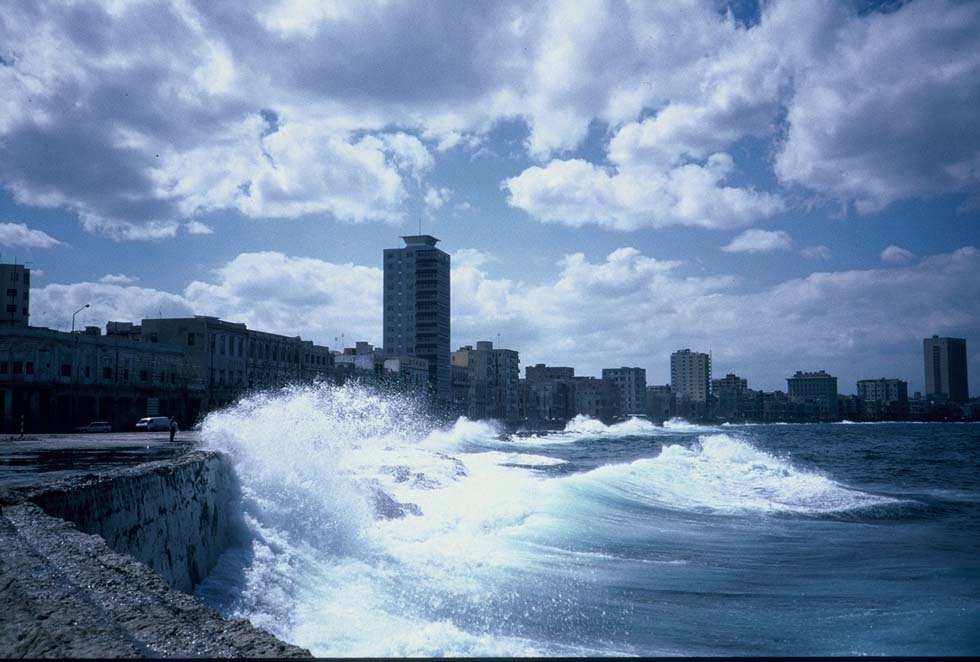
Havana (WS)
Waves are splashing on the Malecon of Havana, the music is as rhythmic as it always has been, but with the revolution shipping had become scarce. Gone have all the complicated lines of the Caribbean and of course also the traditional Peninsular & Occidental. Who knows that in 1850 a coastal service from Santiago de Cuba to Guantanamo had been started by Don Antonio Lopez y Lopez, the Marques de Comillas, with the steamer "General Armero"? Already before, around 1835, the British Admiralty employed the steam boats "Spitfire" and "Flamer" on mail services between Barbados, Jamaica and St.Thomas. In 1837 the "City of Kingston" steamed from London to Barbados in order to be used for inter-island services of the Jamaica S.N.Co. Other local and coastal steamers followed. For the mail steamer services see the chapter South Atlantic/ Caribbean.
Since 1961, Cuba under Fidel Castro was put under sanctions by the USA. During a visit to Havana in 1999 not any passenger ship was there, except a white cruise vessel, pretended to be an "Italia", probably the "Valtur Prima" ex "Italia Prima", the "Stockholm" of 1946. In 2006 however the "Jetkat Express II" of Cubanacan, running from Havana to the tourist resort Varadero, and the hi-speed "Courir" of Aeromar, connecting Batabano with Cayo Largo on the west coast, were listed.
Generally, car ferries in the Caribbean are scarce. In 2003 the "Millenium Express" of Access Ferries (ex "Takachiho Maru") was used for a short period on a San Juan - Santo Domingo route. The Puerto Rico Ports Authority and TS Virgin Islands are providing services in this region. For a Santo Domingo - Mayaguez service by Ferrys del Caribe, Arnold Kludas mentioned the "Caribbean Express" (1976/12,752 gt, ex "Kronprins Harald", "Admiral of Scandinavia"). In Haiti, the capital Port au Prince is linked with Jeremie over a distance of 200 km since years "by small owner-operated boats", as Cook's timetable described it. One of the worst ferry catastrophes with 1,000 victims had been the end of the "Neptuno" off Haiti in 1993. Cook mentioned also a shipping route from Farjardo, Puerto Rico, to St. Thomas and St. Croix. On Guadeloupe - Martinique and neighbouring routes, Express-des-Iles introduced passenger catamarans. For a route Point a Pitre - Fort de France, ShipPax has listed still the 1977-built car ferry "Neptunia" of Marfret During decades the Trinidad & Tobago Government Ferry Service connected Tobago with Port of Spain. For hi-speed services the government-owned TTGS took InCat catamarans on charter. From 2005 transfer of the "Incat 046" from Bay Ferries is reported. And in all the Caribbean region there is a mix of local ferries and tourist boats, impossible to survey.
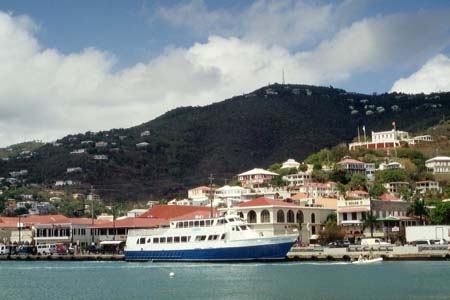 "Capital Venture", bound for St. John, at Charlotte Amalie, St. Thomas 2007 (WS)
"Capital Venture", bound for St. John, at Charlotte Amalie, St. Thomas 2007 (WS)
Mexico Routes
Mexico, where the 'conquistadores' had destroyed a bloody culture, achieved independence in 1821. With the war of 1846-48 however it lost Texas, New Mexico and California to the USA. The important harbour on the Gulf was Vera Cruz, in 1861 occupied by the forces of the 'Tripartite', the European powers which appointed Maximilian to the Emperor of Mexico. He was executed in 1867.
At that time the railway from Vera Cruz inland was under construction, fully completed in 1872. Among the various shipping lines serving the Gulf of Mexico, the timetable mentioned e.g. in 1916 as the only Mexican company the Compania Mexicana de Navigacion with passenger-cargo services from New Orleans to Vera Cruz. Tampico on the Gulf was served by the Ward Line from New York and by the Wolvin Line.
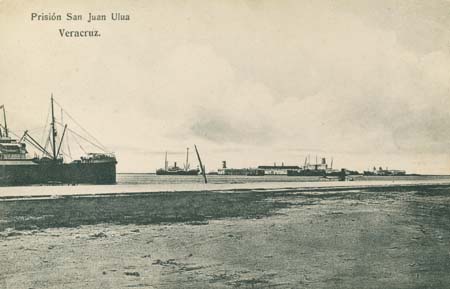
Vera Cruz in the past (old card, coll. WS)
|
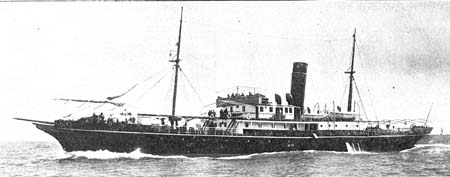
"Salvador" of Salvador Railway, 1910 (Deutsches Museum, Munich)
|
Before completion of the Panama Canal in 1914, the Tehuantepec (Oceanic) Railway from Coatzacoalcos on the Gulf to Salina Cruz on the Pacific coast was of importance. Apart from foreign companies, the Compania Mexicana de Navigacion called at Puerto Mexico (Coatzacoalcos) and the Compania Naviera del Pacifico at Salina Cruz. In the 1920s the Mexican State Line was listed with services between Mexican west coast ports and San Francisco. A steamer connection between Salina Cruz and Acajutla, the railway terminus of Salvador, was provided by the Salvador Railway with their first steamer "Salvador" of 1910.
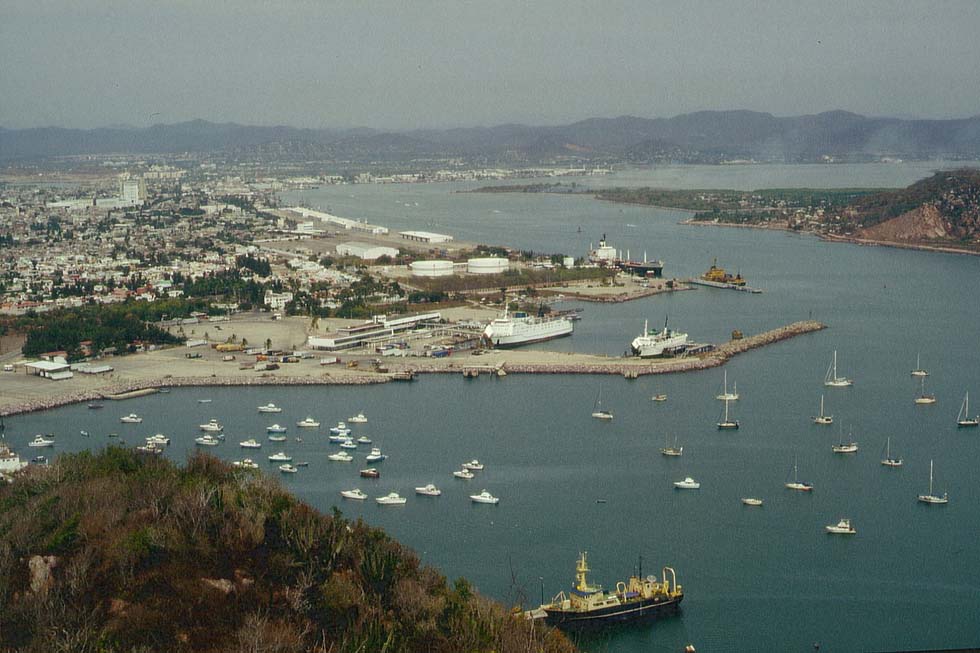
Mazatlan, the port with the "Azteca" for Baja California (left) and the "Benito Juarez", 1995 (WS)
What remained in the age of the jet plane? The ABC Shipping Guide listed at the end of the '70s only the car ferry services between Mazatlan and La Paz, Baja California, by an organization with the complicated name Caminos y Puertes Federales de Ingresos y Servicios Conexos. At the latest from the '80s, Guaymas, Topolobampo, Mazatlan and Puerto Vallarta were connected with the peninsula of Baja California by the Servicio de Transbordadores de Mexico, then Sematur Transbordadores. In 21st century Baja Ferries was listed with services from Topolobampo and from Mazatlan to La Paz. Also Ferry Santa Rosalia connected Baja California with the mainland.
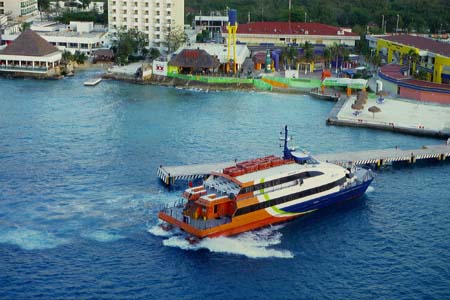 "Mexico V" arriving at Cozumel, International Pier, 2008 (WS)
"Mexico V" arriving at Cozumel, International Pier, 2008 (WS)
On the Gulf Coast of Mexico, the island of Cozumel is connected with the mainland by the boats of Cruceros Maritimos del Caribe, all named "Mexico" with an additional number, the fastest being hi-speed catamarans. Competitors are the UltraMar hi-speeds. ShipPax listed also the car-ferry of Chan Kenab.
Central America
A warm rain goes down over the tiny town with its wooden guest houses and a wooden church on an island at the Caribbean coast of Panama. It's Bocas del Toro. The car ferry to the mainland doesn't work on that Sunday and people take the "taxi", a small boat for a dozen passengers. The ride is hard, waves are splashing, islands and mangrove thickets are passing by, in the south must be the sea with the nice name "Golfo de los Mosquitos". Finally we reach a bay surrounded by poor houses, the harbour's name is Almirante, baptized in honour of Columbus, who once had landed there. That's romantic - but of course that's not the ferry business to be described by this chapter.
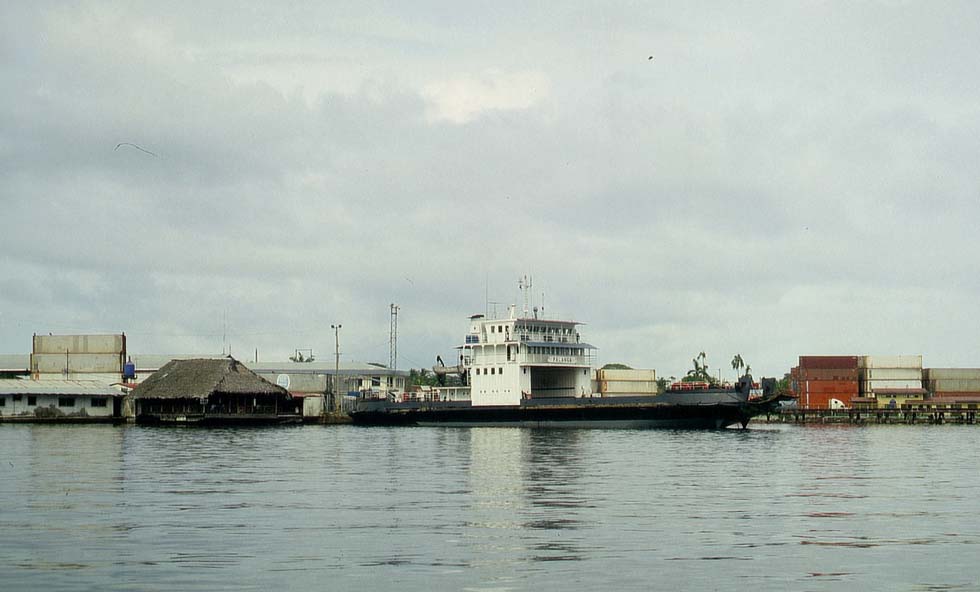
"Palanca", the ferry for Bocas del Toro, Almirante 2006 (WS)
Already in the middle of the 19th century 'Commodore' Vanderbilt operated a combined stage coach and boat service between the Caribbean and the Pacific, crossing Lake Nicaragua. Now the Empresa Portuaria Nacional provides lake services San Carlos - Grenada. A coastal route from Catuco in El Salvador to Puntarenas in Costa Rica became listed by Thomas Cook International timetable with the remark: "Sailings irregular and dependent on tides. Journey 24 hours". Puntarenas had been the Pacific harbour of Costa Rica, since 1879 connected with the capital San Jose by train. Now the railway is abandoned and the small town became quiet, little ferries only for nearby Naranjo and Paquera waiting on the quay. Cargo shipping changed to Port Caldera, where containers are piled up in the tropical forest.
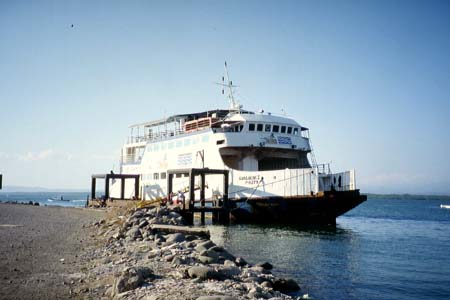
"San Lucas I" of Coonatramar, Puntarenas 2006 (WS)
|
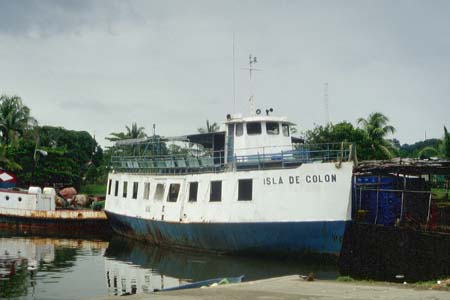
"Isla de Colon" at Almirante, Panama 2006 (WS)
|
Southern neighbour is Panama. That country was still in the 1980s linked with New Orleans by passenger-cargo vessels of Moore McCormack Lines, which continued to Cartagena, Colombia. The harbour on the Caribbean entrance of the Panama Canal is Colon, where tourists were warned not to walk outside the tightly barricaded "Zona Libre". Now they can disembark from cruise ships at the new "Colon 2000" port.
Panama - Colombia
Central America has no road connection with South America. The Interamericana is ending close to the border of Colombia in the jungle. A car ferry service circumventing that region of drug gangs was prepared by the Promotora de Navigacion, supported by the Silja Line. In 1994 the chartered "Crucero Express", the former "Bolero" (1977/11,344 gt) of Fred Olsen, then "Jupiter" of Color Line, started services Colon - Cartagena. It was not successful and in 1996 that connection ended - though it had been used by some courageous globetrotters with their caravan or even by some motorcyclists. A couple who arrived in Panama, coming from Florida riding their 'Gold Wing', told us that story...
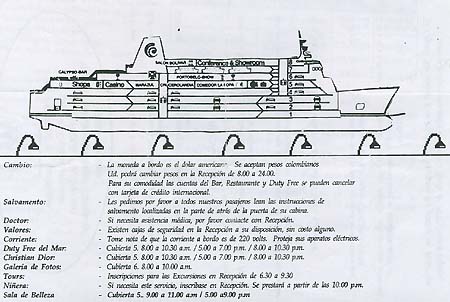
"Crucero Express" Colon - Cartagena, 1995 (coll. Helmut Hasslauer)
|
|
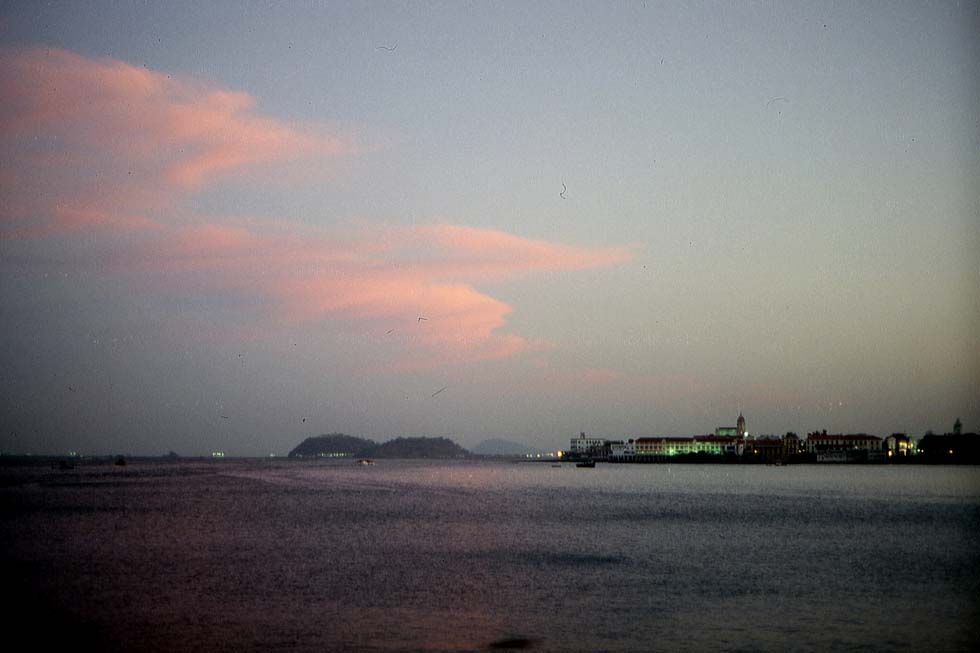
Panama Ciudad (WS)
|